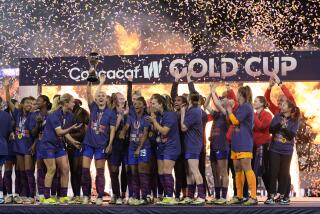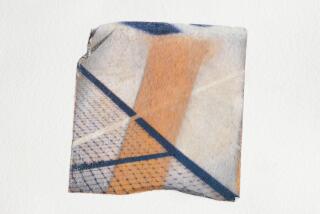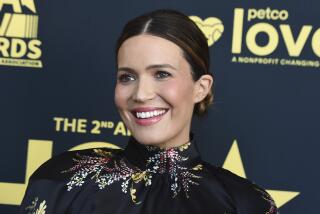No Magic Answers Here
MELBOURNE, Australia — Athletes In Acting.
Sure, it’s always harder than it appears. For every star turn, like Kareem Abdul-Jabbar in “Airplane,” there is a wooden Wayne Gretzky on “Saturday Night Live.”
Teenager Andy Roddick was finding this out shortly before Christmas at the Los Angeles Tennis Club, even though he was playing himself, not required to sing or dance. “I probably wouldn’t have been caught dead doing a play,” he said.
Hollywood wanted him to be himself. No problem ... once the cameras stopped rolling on the set of “Sabrina the Teenage Witch.” Sabrina, played by Melissa Joan Hart, was spraying balls, off the court, and right at Roddick.
“You hit the ball well, Sabrina, you just have to learn how to hit it in the court,” Roddick said.
Roddick was asked to project more. There are similarities to his day job, of course, doing the same thing over and over for hours. Once you get something right, something else goes wrong.
“I get the dialogue right and then I don’t step out,” Roddick said.
He’s had those days on the court, too. The serve is fine, but the volley isn’t.
At the club, there was no crowd of 15,000, cheering his every gesture. In some ways, it’s tougher in front of the small crew and cast on location. “I just don’t want to mess up,” he said.
Even Roddick couldn’t help Sabrina, who had to resort to magic to compete against her boyfriend on the court. And, maybe there should have been some sort of cosmic tradeoff--she could have summoned her powers to change his lousy draw at the Australian Open, which starts Monday.
You begin to wonder about magic, superstitions and flat-out bad luck for the top Americans when the 13th-seeded Roddick landed in the same quarter of the draw as two-time defending champion and third-seeded Andre Agassi, No. 8 Pete Sampras and No. 9 Marat Safin of Russia. What’s this? Legends vs. kids?
Still, any conspiracy theories are dismissed when the case of Australian favorite Lleyton Hewitt is considered. The U.S. Open champion and top-ranked player, who is recovering from a recent run-in with chicken pox, was not exactly handed a cure when the draw came out. He will open against Alberto Martin of Spain and is in the same half as Agassi, Sampras, Roddick and company.
The women’s draw is not nearly as unbalanced. Venus Williams, seeded second, will try to win her third consecutive Grand Slam, following her Wimbledon and U.S. Open titles in 2001. For the first time, she has put in early preparation in Australia, winning the Gold Coast tournament two weeks ago. Williams is unbeaten in 20 matches since losing to Meghann Shaughnessy in Palo Alto in July.
She could meet her younger sister, fifth-seeded Serena Williams, in the semifinals if Serena gets past a possible quarterfinal against No. 3 Martina Hingis of Switzerland. Hingis, who was trying to win her first tournament in 11 months on Saturday in Sydney, has played in the last five Australian Open finals, winning three. Her last Grand Slam title was the 1999 Australian Open, but since losing the top ranking last year, Hingis seems to have relaxed, adopting the role of challenger.
Lindsay Davenport, recovering from knee surgery, will not play.
Defending champion Jennifer Capriati is coming off a shaky performance in a three-set loss to Alexandra Stevenson in Sydney, and finds herself in the same half of the draw as Belgians Kim Clijsters, seeded fourth, and Justine Henin, seeded sixth. Stevenson and Anna Kournikova would be considered two dangerous, unseeded floaters, if not for their first-round draws.
Stevenson will play No. 10 Shaughnessy in the first round, and Shaughnessy beat her in the quarterfinals in Sydney and reached the final when Serena Williams retired because of injury. Kournikova will meet Henin in her first match at Melbourne.
An early Kournikova departure would turn full Australian attention back to the fortunes of Hewitt and his troublesome draw. His quarter is almost ridiculously loaded with talent. There’s 11th-seeded Roger Federer of Switzerland, No. 7 Tommy Haas of Germany and two former Australian Open finalists, Carlos Moya of Spain and Marcelo Rios of Chile. Federer won the tour event in Sydney after beating Roddick in the semifinals. Rios, a former No. 1, is one of the most dangerous floaters, along with Australian Mark Philippoussis, who is in the lower half.
And, another former Australian Open finalist is in Hewitt’s portion of the draw: No. 15 Arnaud Clement of France, who lost to Agassi in straight sets in last year’s year’s final.
This tournament has not been kind to native sons. It has been almost 14 years since an Australian male reached the final (Pat Cash), and the most recent singles champion was Mark Edmondson in 1976.
Hewitt lost early in Melbourne last year, but it seems more like five years ago the way he has evolved. After winning the U.S. Open in September, Hewitt has not relented, becoming the youngest player to reach the No. 1 ranking. One of his lesser-known accomplishments, outside of Australia, was his stunning victory in the quarterfinals of the Davis Cup against Gustavo Kuerten, on Kuerten’s home clay turf in Brazil.
The setting was different in New York at the Open, but it had a Davis Cup-type feel when Hewitt faced Roddick in the quarterfinals. Roddick exploded after a controversial overrule late in the fifth set and lost the match, throwing one of the most explosive temper tantrums of his young career.
Roddick regained his equilibrium quickly after the loss, thanking the crowd for the support. But it remains a defining episode and he spoke about it during a break from trading shots with Sabrina.
“It’s almost embarrassing,” he said of his outburst. “That’s something I’ve been working on. I’ve been seeing a sports psychologist [in Boca Raton], so I’ll have my fire. But I’m going to have it in check. That’s definitely important. That’s a big part of my energy and where my power and energy come from. At the same time, I need to be able to step out of the situation and see it, from the outside looking in, to say, ‘Mellow out.’
“We’re looking at ways, if I feel myself wandering, to snap out of it and get back into the flow. The fans there were so great. I didn’t need them to hear me crying about everything. I was lucky to be out there playing. I saved my fumes for when I was away from everybody.”
So what’s next, hypnosis?
Roddick shook his head but was quick with a one-liner.
“Every time, I hear a bell ring, I have to cluck like a chicken,” he said.
This will be Roddick’s first Australian Open as a professional. Last year, he realized he needed more matches and went to a challenger event in Hawaii, and won it, instead of making the long trip to Melbourne for qualifying. Unlike others before him, he welcomes the hype, although not indulging in it but taking the best it has to offer, like parts on WB shows.
“It’s definitely different,” he said. “I had a lot of exposure this year. I’d rather have it that way than the other way because that means you’re winning matches. I like to set short-term goals, so I feel like I’m close to it.
“If you set something like, ‘Career goal, I want to win 10 Grand Slams.’ But if you’re sitting here at none, then it seems a little unrealistic. If I set a goal, I want to be top-whatever [before] Ericsson, it gives you something to strive for, something to go for.”
More to Read
Go beyond the scoreboard
Get the latest on L.A.'s teams in the daily Sports Report newsletter.
You may occasionally receive promotional content from the Los Angeles Times.











